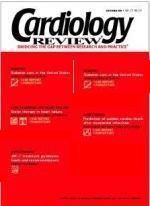Case report: Posttransplant endothelial dysfunction and CAD
A 60-year-old man with a medical history of hypertension and tobacco use was transferred to the hospital for decompensated left ventricular dysfunction and hypoxemic respiratory failure after an acute anterolateral wall myocardial infarction and five-vessel coronary artery bypass graft surgery. He was stabilized using inotropic support but could not be weaned. He was scheduled for cardiac transplantation and underwent a successful and uncomplicated orthotopic heart transplant.
Echocardiography after transplantation revealed normal valvular, right, and left ventricular function with enlarged, composite atria. Initial endomyocardial biopsy re-
vealed no acute rejection. Baseline cardiac catheterization showed normal coronary arteries in a right dominant system without atherosclerosis by coronary angiography. Intravascular ultrasonography revealed coronary arteries with two areas of mild intimal hyperplasia. Vasomotor reactivity in response to intracoronary acetylcholine infusion demonstrated mild vasoconstriction. His lipid profile was notable for a total cholesterol of 203 mg/dL, low-density lipoprotein (LDL) cholesterol of 113 mg/dL, high-density lipoprotein (HDL) cholesterol of 47 mg/dL, and triglycerides of 155 mg/dL.
Posttransplant course
Over the subsequent year, the patient became obese and hyperlipidemic, with increased total and LDL cholesterol levels as well as a decrease in HDL level. He was treated with niacin to reduce his LDL level
(< 100 mg/dL). He developed glu-cocorticoid-induced diabetes. One surveillance biopsy revealed mild rejection requiring increased corticosteroid dosage. Routine annual cardiac catheterization showed normal coronary arteries by angiography. Acetylcholine infusions resulted in significant vasoconstriction, especially as compared with baseline, without impaired coronary flow reserve. Intravascular ultrasonography detected significant increases in intimal thickness with new, focal areas of circumferential vasculopathy, as well as progressive intimal hyperplasia of previously detected lesions. Echocardiography showed mild left ventricular hypertrophy, mild mitral regurgitation, normal left and right ventricular function, and mild tricuspid regurgitation.
Conclusion
Survival after cardiac transplantation is limited by transplant-me-diated coronary artery disease (CAD). Hyperlipidemia frequent-
ly develops and may contribute
to endothelial injury. Endothelial dysfunction is common soon after transplantation and may be an early marker of transplant-mediated CAD. Early use of HMG-CoA reductase inhibitors (statins) prevents dyslipidemia as well as worsening of endothelial function while preventing development of transplant-mediated CAD. Although the coronary
angiogram demonstrated little atherosclerosis, the intravascular ul-
trasound revealed significant de-
velopment of posttransplant CAD. Several studies have demonstrated that the prophylactic use of statins reduces development of such CAD, even with relatively normal cholesterol levels.
